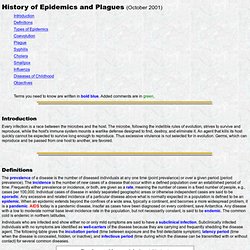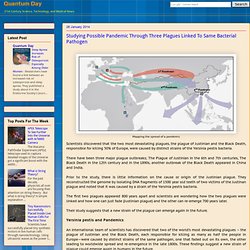

Spanish Flu. Disease in History. Primer on Public Health Population. Chapter 1 introduced the natural historyof a disease, from exposure to causal agents through to its progression and final outcomes.

Understanding the characteristic natural history of a disease enables physicians to anticipate prognosis and to identify opportunities for prevention and control.1 For instance, based on what is known of Type 2 diabetes, Dr. Rao can be concerned that Catherine Richards may face visual impairment, kidney failure, and possible amputation if she does not take measures to control her disease.
Understanding the natural history can also tell us roughly the time frame within which we have to intervene to alter the clinical course of her diabetes and prevent the development of more serious consequences. Ideally, prevention occurs before people contract a disease, so preventive programs are often delivered to currently healthy people in the general population. Figure 4.1: Clinical course of a disease: four prevention stages.
12 Diseases That Altered History. Diseases and Vaccines — Timelines — History of Vaccines. The 10 Worst Disease Outbreaks & Epidemics in U.S. History. 1830-1851: Second Cholera Pandemic To this day, cholera, an infection of the small intestine, still affects between three and five million people and causes nearly 130,000 deaths a year worldwide (CDC, 2011).

However, the last documented outbreak in the United States was in 1911 (Mayo Clinic, 2011). Before then, there were a number of outbreaks, but none worse than the Second Cholera Pandemic of the mid-1800s. The pandemic began in India, and then swiftly spread across the globe via trade routes. Settlers travelling along the Mormon and Oregon Trails brought cholera to the United States from East to West, killing an estimated 150,000 Americans (Beardslee, 2000). Vaccinate Your Baby : History of Disease Eradication. Diseases and epidemics. British Sign Language description Audio description 'The ideal way to get rid of any infectious disease would be to shoot instantly every person who comes down with it.' H L Mencken Humanity and disease share a long and eventful history.

As we emerged and evolved, so did the diseases that blight our lives. Diseases exist in the fossil record, but our ancestors were actually less exposed to them. What did early people think about disease? Like their prehistoric ancestors, most Ancient Egyptians blamed evil spirits or angry gods. 7 Worst Killer Plagues in history (worst diseases, epidemics in history) Smallpox (430 BC?

- 1979): Killed more than 300 million people worldwide in the 20th century alone, and most of the native inhabitants of the Americas Smallpox (also known by the Latin names Variola or Variola vera) is a contagious disease unique to humans. Smallpox is caused by either of two virus variants named Variola major and Variola minor. The deadlier form, V. major, has a mortality rate of 30–35%, while V. minor causes a milder form of disease called alastrim and kills ~1% of its victims. Long-term side-effects for survivors include the characteristic skin scars. Smallpox killed an estimated 60 million Europeans, including five reigning European monarchs, in the 18th century alone.
Top 10 Worst Plagues In History. Health History is dotted with epidemics and plagues, but a certain number of them stand out as unique for their severity and impact on future generations.

10 Worst Epidemics. Few words in the English language encapsulate as much horror, misery and doom as "plague.

" After all, infectious diseases have inflicted a great deal of damage throughout the centuries. They've decimated whole populations, ended blood lines, claimed higher casualties than wars and played pivotal roles in charting the course of history. Early humans were no strangers to disease. History of Plagues. History of Epidemics and Plagues (October 2001) Introduction Definitions Types of Epidemics Coevolution Plague Syphilis.

The Great Plagues: Epidemics in History from the Middle Ages to the Present Day. The Great Plagues: Epidemics in History from the Middle Ages to the Present Day Epidemic diseases have been as important as war in their devastating effects on human society through the ages.

Studying Possible Pandemic Through Three Plagues Linked To Same Bacterial Pathogen. Scientists discovered that the two most devastating plagues, the plague of Justinian and the Black Death, responsible for killing 50% of Europe, were caused by distinct strains of the Yersinia pestis bacteria.

There have been three major plague outbreaks; The Plague of Justinian in the 6th and 7th centuries, The Black Death in the 12th century and in the 1890s, another outbreak of the Black Death appeared in China and India. Skeletons point to Columbus voyage for syphilis origins. Public release date: 20-Dec-2011 [ Print | E-mail Share ] [ Close Window ] Contact: Beverly Clarkbeverly.clark@emory.edu 404-712-8780Emory University Skeletons don't lie.

But sometimes they may mislead, as in the case of bones that reputedly showed evidence of syphilis in Europe and other parts of the Old World before Christopher Columbus made his historic voyage in 1492. None of this skeletal evidence, including 54 published reports, holds up when subjected to standardized analyses for both diagnosis and dating, according to an appraisal in the current Yearbook of Physical Anthropology. "This is the first time that all 54 of these cases have been evaluated systematically," says George Armelagos, an anthropologist at Emory University and co-author of the appraisal. "Syphilis has been around for 500 years," Zuckerman says. Medieval skeletons give clues to leprosy origins.
13 June 2013Last updated at 14:10 ET By Melissa Hogenboom Science reporter, BBC News As part of their study, scientists extracted DNA from skeletons that were 1,000 years old The genetic code of leprosy-causing bacteria from 1,000-year-old skeletons has been laid bare. Similarities between these old strains of the bug and those prevalent today have given scientists unique insights into the spread of the disease.
It has revealed, for example, the key role played by the medieval Crusades in moving the pathogen across the globe. The researchers tell Science magazine they hope their study will lead them to the ancient origins of the leprosy. In medieval times, a sufferer of leprosy was likely to be an outcast, secluded from society in quarantined colonies. Continue reading the main story Historic stigma Leprosy sufferers were often quarantined in living areas called leprosaria. "Leprosy was the only disease in medieval Europe that elicited a specific institutional response.
Animals and Disease: An Introduction to the History of Comparative Medicine - Lise Wilkinson. Epidemics and History: Disease, Power and Imperialism - Sheldon J. Watts. Global Burden of Disease and Risk Factors. Heredity and Infection: The History of Disease Transmission. Health and Disease in Human History: A Journal of Interdisciplinary History ... No Magic Bullet: A Social History of Venereal Disease in the United States ...
Pox, Pus & Plague: A History of Disease and Infection - John Townsend. The Deadly Truth: A History of Disease in America - Gerald N. Grob. The History of a Genetic Disease: Duchenne Muscular Dystrophy Or Meryon's ... - Alan E. H. Emery, Marcia L. H. Emery.